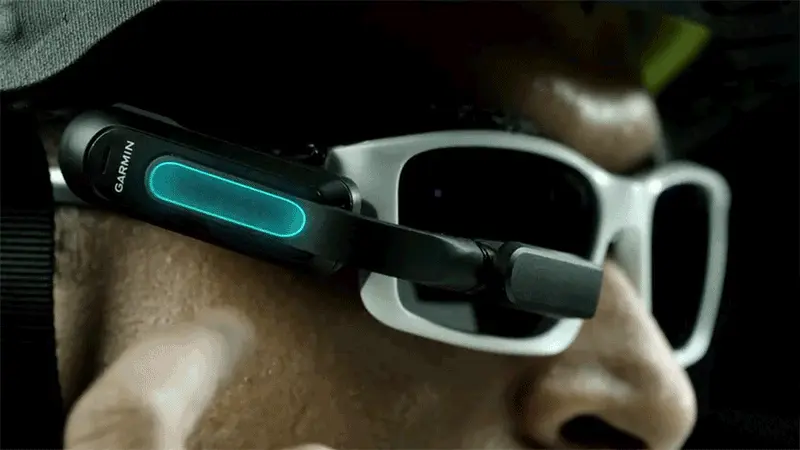Wouldn’t it be neat if your sunglasses were smart enough to tell you where you misplaced them five minutes ago? Say, that local Starbucks you always visit while on your bike ride? One can dream, can’t one?
Instead, you’ll just have to settle for sunglasses that alert you of calls or texts while you’re out peddling, as well as provide information about your heart rate, power, speed, if you’re into tracking your exercise. Oh, let’s not forget your sunglasses also can provide detailed navigation prompts, complete with street names, directional arrows and distance to turn. So, even though your sunglasses may not remind you where you misplaced them, they’ll at least guide you to wherever you left them.
By the way, you can make your favorite pair of sunglasses - any pair you own, actually - capable of these “smarts,” courtesy of the Varia Vision. The device, which clips to either temple of your shades to put ride information in your line of sight, eliminates the need to take your eyes off the road for information.
The technology behind the Varia Vision and other devices like it represent the augmented reality (AR) eyewear market, a segment of the global wearable computing market whose technologies are poised to disrupt major consumer markets.
WHAT ARE WEARABLE COMPUTERS?
Wearable computers are small electronic devices worn by the user under, with, on top of or as clothing that enable mobile computing and wireless networking,
according to BCC Research analyst Adam Weigold.
“They’re especially useful for mobile applications that require more complex computational support than just hardware coded logics in a hands-free arrangement. By this definition a standard wristwatch that tells time is not a wearable computer, but is an early ancestor of the technology,” he explains.
Recent advances in materials sciences, electronics, photonics and software are enabling a potentially vast range of new lightweight, wearable computing products to emerge, like the Varia Vision, he says.
“Until now, wearable computing products, or ‘wearables’ as they’re becoming known, have been a fringe market of curious devices that have been impractical, bulky and unaesthetic for consumer applications,” he notes. “Traditional markets for wearable devices have primarily been focused on non-consumer niche applications including those in healthcare, defense/security, enterprise and industrial markets.
“However,” Weigold says, “wearables are poised to go mainstream.”
WHAT IS AUGMENTED REALITY EYEWEAR?
These “smart glasses” overlap externally fed data and visual images with the wearers’ natural field of vision. The augmented reality device market has been around for several decades with products traditionally comprised of large bulky Head Mounted Displays (HMD’s) mounted on helmets, according to Weigold. These legacy HMD products have primarily focused on gaming, defense, security and healthcare applications.”
Weigold says, “Broadly speaking, AR eyewear like Garmin’s clip-on device can act as a central control and visual display interface that communicates and interacts with other devices worn about the wearers’ body. In some incarnations the smartwatch or eyewear device acts as a standalone control system while in other configurations the AR eyewear device may integrate with a smart device.”
TECHNOLOGICAL CHALLENGES
A major challenge facing the wearable industry is identifying the ideal design format and ultimate performance configuration that will broadly appeal to all consumers. The entrance of existing smartphone manufacturers into the market helps ensure that this ideal design format compliments and enhances smartphones rather than competes with them.
“Recent technological advancements have transformed these large HMD products into smaller, lighter devices integrated within conventional eyeglass and visor designs (termed collectively as eyewear). Technology innovators such as Vusix and Google have led the way in developing miniaturized photonic display technologies that provide the wearer of lightweight AR eyewear devices with real-time visual information and data communications while also interacting normally in the real world.”
Garmin’s AR product, which weighs one ounce, displays up to four data fields plus color-coded graphic displays at any one time. Users control the device using a tiny touch pad on the body on which they swipe for menu changes and tap for sub-menu options. Call and texts are bounced via Bluetooth from a paired phone. The usual cycling metrics are visible and customizable. While the Varia Vision can be attached to any pair of sunglasses, it’s powered only by Garmin’s Edge products.
According to Weigold, AR eyewear products may ultimately compete directly with smartwatches as a portable central command and communications platform in consumer markets. However, many challenges remain for AR products to overcome including aesthetics, usability, personal privacy and consumer fear and apprehension about a technology that can
change the wearers’ perception of reality.
FUTURE DEVELOPMENTS FOR AR EYEWEAR
Augmented Reality eyewear has reached the miniaturized size capable of being integrated within a conventional eyewear format similar to reading glasses or sunglasses. This means that these devices can now be designed that meet many of the aesthetic and style demands of the broad consumer market. In the general consumer market price, usability and privacy issues will slow the adoption of these devices compared with equivalent smartwatch products.
Nonetheless, smart glasses will find traction in some consumer markets including gaming and sports and fitness, predicts Weigold. They will also find a new range of applications in non-consumer markets such as enterprise and healthcare. Future technological advancements are already being made to further reduce the size of augmented reality displays, which may in turn create more niche applications.
BCC projects that the world market for wearable products will grow from about $3.1 billion in 2012 to around $5 billion in 2013, and exceed $30 billion by 2018, reflecting a compound annual growth rate (CAGR) of 43.4% between 2013 and 2018. The majority of growth will come from consumer markets, which are poised to grow rapidly from 2014 onward.



